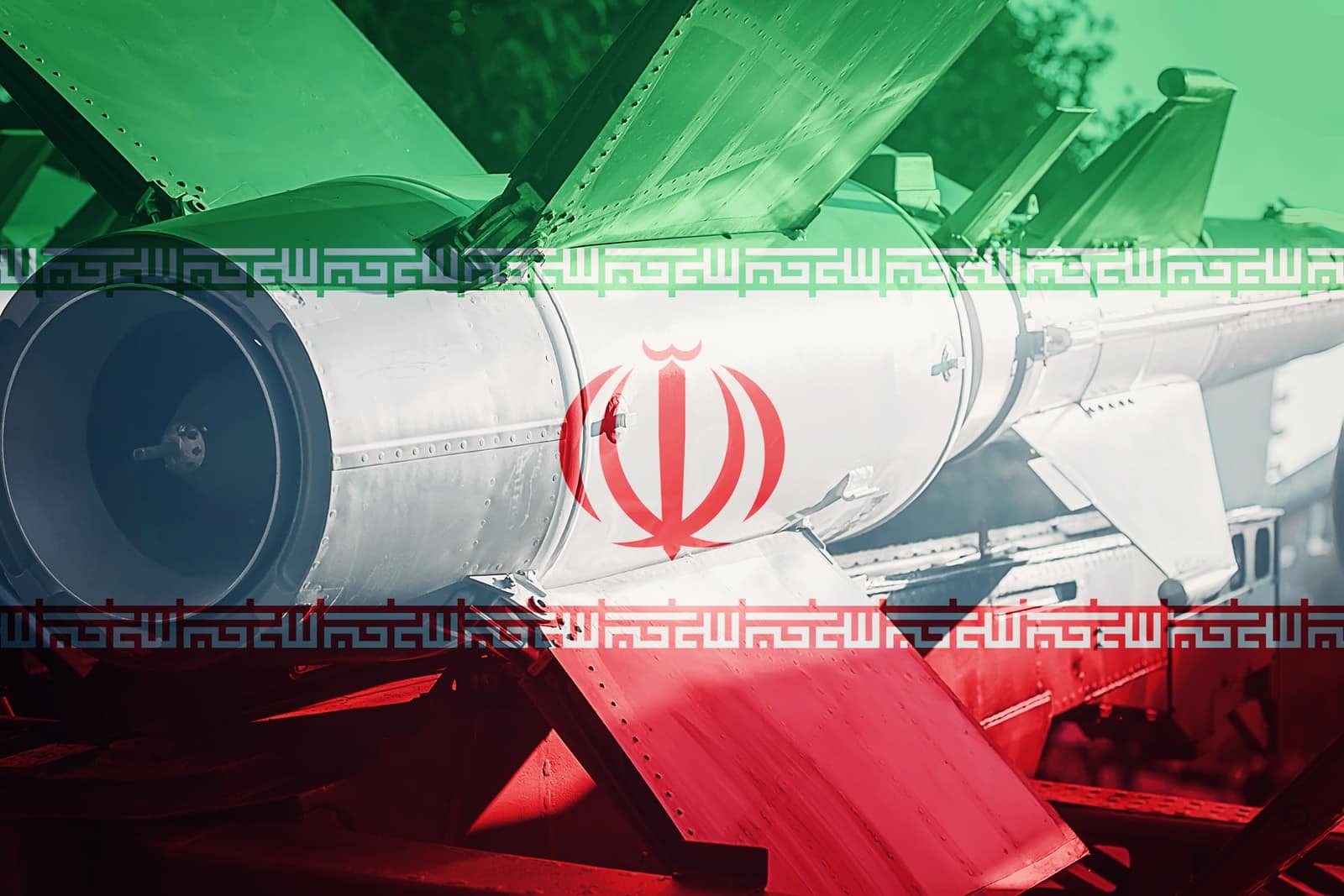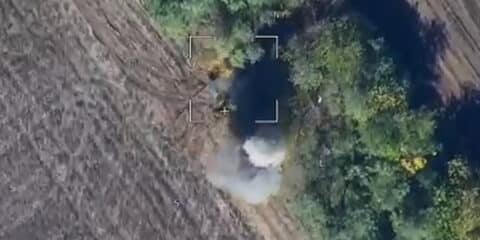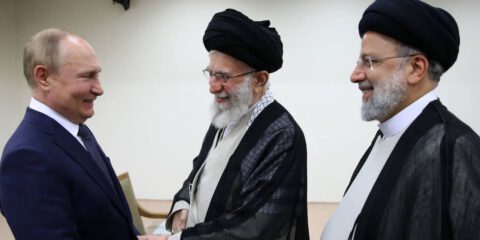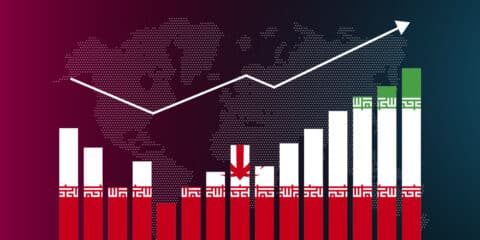It is highly unlikely that Iran will agree to any limitation on its missile programs, despite Trump administration pressures. For Iran’s leadership, to concede on missiles is to concede on the regime’s global ambitions.
Introduction
Overall, Western and Israeli observers perceive Iran’s missile forces as routine components of its military buildup. This perception is rooted in the traditional Western military doctrine in which air power, consisting of fleets of manned combat aircraft, is the main strike force both tactically and strategically. The same doctrine relegates short and medium range missiles to supportive roles: weapons that can be useful to achieve military or strategic decision but cannot do so by themselves. Western analysts regard battlefield missiles as significant weapons only when they carry nuclear (or other WMD) warheads. “Conventional” – that is non-nuclear missiles – are perceived as hardly significant in the West. In line with this perception, the prevailing view in the Israel Defense Forces (IDF) until recently has been that “missiles don’t win wars.”
Iran’s view is exactly the opposite. The death and destruction in Iran’s cities from Saddam Hussein’s conventional missiles during the so called “war of the cities” in 1988 forced Ruholla Khomeini, the founder of the Islamic Republic, to ask for a cease fire and thereby lose the war. The lesson was etched in Iran’s national memory: missiles do win wars. No less significant, it was during that war that Iranian engineers and soldiers embarked on achieving their own missile capability, that in time matured into one of the richest and most prolific missile programs in the world. The efforts of those young Iranian engineers and soldiers, who, virtually under fire, brought, assembled and launched the first Iranian ballistic missiles are celebrated today in Iran for their heroic effort in what is perceived as the decisive War of Liberation from Western Imperialism. Conventional missiles are therefore regarded as strategically decisive weapons, associated with heroism and martyrdom. This mix of nostalgic and pragmatic considerations have promoted missiles into a ranking position in Iran’s defense priorities – regardless of the degree to which this differs from how the West relates to conventional missiles.
The following paper offers a detailed analysis of the crucial role assigned to Iran’s missiles by the Islamic regime in its pursuit of its global, world changing ambitions. Iran’s attitude towards its missile programs, based as it is on both emotional and rational considerations, makes it highly unlikely that it would agree to any limitation on those programs, despite the considerable pressure of President Trump’s administration. From the perspective of Iran’s leadership, to concede on missiles is to concede on its global ambitions. Any such concession is unlikely without a change in Iran’s regime policy, if not a change of the regime itself.
The Global Vision of the Islamic Republic of Iran
The Islamic Republic loves military parades. Twice a year, major military parades march through the main thoroughfares of Tehran and other major cities: The month of April celebrates “Army Day” with a series of parades in Tehran and other major cities, while in the month of September celebrations of the “Martyr’s Week” that commemorates the Iran-Iraq War ushers in another series of major parades. The April parades feature the Iran’s Armed Forces – the legacy armed forces inherited from the toppled regime of Iran’s imperial dynasty. The September parades, however, feature the Islamic Revolutionary Guard Corps, a military organization established by Imam Khomeini shortly after he seized power, and designed to be a bulwark against a coup by the legacy armed forces, suspected of vestigial loyalty to the deposed Iranian shah.
The April and September parades showcase Iran’s military might and the latest achievements of its defense industries. It is the September parades that attract the most attention, however, because they feature Iran’s ballistic missiles. It should be noted that the most recent parade on September 22, 2018 was marred by a terror attack on the parading troops in the western Iranian city of Ahwaz in which 95 civilian and soldiers were hurt, of which 25 died. This terror attack was headline news worldwide, diverting attention from the main parade held, undisturbed and uninterrupted, in the capital city of Tehran and presided by the President, Hassan Rouhani
The September parades consist of three parts. The first part, a march, is headed by veterans of the Iran-Iraq War, some of them in wheelchairs, followed by regular infantry formation of the Revolutionary Guards. The second part features mobile ground weapons such as tanks, mobile artillery and transportable command centers.
Following the second part of the parade, as a prelude to the third, trucks convey giant billboards with praises to the Islamic regime and invectives against its foes. Customarily, several billboards carry English slogans proclaiming, “Down with the US” and “Down with Israel”, as well as “Death to America” and “Death to Israel” in Arabic and Persian. This presentation of contradictory messaging – using harsh terms in local languages and softening the message for English speaking audiences is typical not only of Iran but of radical states and non-state actors across the Middle East.
Following the slogans come the long columns of growling mobile launchers, featuring the full spectrum of Iran’s missiles from tactical to strategic. This show is narrated by an unseen, very emotional announcer who repeatedly invokes the name of God the Almighty. The missiles too are accompanied by mobile billboards listing their names and specifications. This year, viewers were surprised to discover a new kind of billboard apparently unrelated to the snaking columns of missiles preceding and trailing it. The billboard carried the image of Iran’s current supreme leader, Ali Khamenei and without the matching image of his predecessor Ruhollah Khomeini as is customary in such occasions. The billboard featured a text in Persian followed by an English translation: “Imam Khamenei: Islamism, anti-imperialism, preserving the independence of the country, dignifying mankind, defending the oppressed and thorough progress and development of Iran are the main goals of the Islamic Revolution.”
It is not too difficult to fathom the regime’s intention in embedding a declaration of lofty ideals in a muscular missile show. Given the US withdrawal from the Iran nuclear deal and the threat of the return of economic sanctions it has become crucial that Iran preserves its good relations with European Union to mitigate against the sanctions’ bite. Painting the objectives of the Islamic revolution as lofty ideals can be seen as a conciliatory gesture towards the EU, a union purportedly based on values (rather than self-interests). Although somewhat clumsy, this is a message clearly conveys to the Europeans that beyond all this saber rattling and beyond their joint pecuniary interests, Iran shares with them lofty human rights ideals.
And what are those “lofty ideals”? Of the six objectives listed by Khamenei, two are particular to Iran itself: preservation of independence and thorough development of the country. Another two are more universal: advancing Islam and resisting Imperialism. The final two objectives are even more universal and – at least superficially – align with Western post-modern liberalism and identity politics, namely “dignifying mankind” and “defending the oppressed”. It stands to reason that the “oppressed” in this context are not women or homosexuals, but Shiite Muslims, perceiving themselves as “the oppressed” of the Islamic world. The Iranians quite astutely left the point vague.
Yet the main message here was not the declaration of the Islamic Revolution core values, but the combination of them together with the display of naked missile power. This testifies to the nearly mythical stature of missiles in Iran’s self-perception as well as on their central role in its national security policy and on their crucial l role in its attaining Iran’s objectives.
What is Iran’s national security policy and its national objectives? The literature offers of wealth of information and interpretations highlighting various aspects of this question. For the purpose of this paper, we shall use a list of objectives detailed in an article published about a decade ago by an Israeli think tank:
- Preserving the Islamic regime of Iran
- Preserving the territorial integrity of Iran
- Advancing the economy and other national objectives through the exploitation of natural resources (i.e., oil income rather than foreign capital)
- Leadership of the Islamic world
- Achieving the status of a global power
- Achieving hegemony in the Middle East by influence rather than territorial aggrandizement
In this list of national objectives, three relate to promoting Iran from a humdrum regional country to become a regional power and thereafter to membership in the exclusive club of global powers. The key is a hegemonic position in the Middle East. Such hegemony would give Iran control of about half of the global fossil fuel reserves and elevate it to the de facto leader of the entire Islamic world, from Morocco to Indonesia. If Iran were to become the supreme energy power as well as the voice of the Islamic world, it could demand and receive its due position among the global powers, equal in stature to the US, China and Russia – or so at least theorized Iran’s former president, Mahmoud Ahmadinejad. The road to hegemony however lies not through military occupation or enslavement of other Middle Eastern countries, but through projecting power and influence that turns those same countries into willing allies or outright satellites – in other words, “exporting the revolution.”
Principles of Force Structure
The principles of Iran’s military force structure and organization are derived from the above objectives. The primary principle is that of force duality: the existence and maintenance of two parallel military organizations side by side, namely the Iranian Armed Forces (IAF), legacy of the previous Imperial regime, and the Islamic Revolutionary Guard Corps (IRGC) which operates its own armed formations parallel to those of the legacy IAF. The two parallel military organizations as well as all internal arm bearing forces such as the national police, report to a general staff headed by the supreme leader (currently Ali Khamenei). The purpose of this duality is to secure the Islamic leadership against any putsch attempt from the IAF, suspected – at least during the early years of the Islamic Revolution – of harboring aspirations of re instituting the Imperial regime. The IRGC is thus the bodyguard of the Islamic regime. Note that the dual force structure is not unique to the Islamic Republic and is rather popular among some other autocratic regimes in the region.
Both the IAF and IRGC are organized and equipped to defend the national territory rather than to invade and occupy neighboring territories. The total number of troops in the IAF and IRGC is estimated at half a million, but their equipment is rather dated. The Iranian Air Force operates a large number of relatively obsolete aircraft, some of which hail from before the Islamic Revolution. The ground forces continue to operate obsolete armored fighting vehicles, and the naval forces operate many small surface ships and submarines. Aging armaments are the hallmark of both armed forces. In the wake of the nuclear deal and the lifting of UN imposed sanctions, Iran began negotiating the purchase of modern combat aircraft and tanks from Russia, but as of now – three years after the sanctions were lifted – no agreement has yet been announced. According to Iranian opposition sources, the IRGC vetoed a plan by the IAF to purchase advance MIG fighter aircraft and modern T90 tanks.
Iran military forces are not equipped to invade foreign lands, but rather to defend the national territory. They can sustain and deflect attacks on the national territory and they certainly project power within the region, mainly by means of conventional (i.e. non-nuclear) missiles. The military nuclear program is – at least presently – more of a political bargaining chip than a full-fledged weapon development and manufacturing program with definite budgets, objectives and timetables; or so this author believes. The Islamic leadership perceives conventional missiles as strategic weapons that can decide the outcome of military conflicts, presumably because of Iran’s bitter experience during the “war of the cities” in the late 1980’s. By contrast, this perception of non-nuclear missiles as decisive weapons is foreign to Western armed forces, which rely on sophisticated air forces for power projection and war winning. To Western military thinking, on nuclear missiles are strategically significant. Non- nuclear missiles are counted as support weapons on par with long range artillery.
From Iran’s perspective, Saddam’s non-nuclear missiles won him the Iran-Iraq War, forcing a recognition that missiles are strategically decisive. The accumulated evidence from the battlefields of Syria and Yemen tend to reinforce this perception. Moreover, if and when Iran embarks on building nuclear weapons, the existing fleets of non-nuclear missiles could easily be adapted to carry first-generation nuclear warheads. Overall, Iran’s missiles are designed for the dual purpose, and are produced in large numbers both to impress and deter as well as to win wars without recourse to weapons of mass destruction.
The Strategic and Tactical Role of Iran’s Missiles
Iran’s choice of missiles over air power as a mainstay of its strategic strike force and power projection seems to be driven by a mixture of pragmatic and emotional factors. Emotionally, missiles carry the heroic legacy from the Iran-Iraq war, during which the first units of ballistic missiles were set up. The stories of the first Iranian missile unit, established to retaliate in kind against Saddam’s missile attacks on Iran’s cities, continue to be featured in Iran’s media to this day. Pragmatically, Iran regards non-nuclear missiles as strategic weapons that can decide the outcome of wars. Equally important, missiles are state of the art systems that require cutting edge scientific and technological expertise to develop and manufacture them. Hence, missile industries are nurseries of quality technical manpower for the military industry and for Iran’s economy at large.
In consequence, Iran refuses to accept any foreign imposition of operational or quantitative limitation on their missiles. At the same time, the regime has made public two self-imposed limitations: First, that their missile will never be equipped with nuclear warheads, and second, that their range will be limited to 2000 km. Those two voluntary limitations are skillfully recycled. Whenever Western leaders mention the need to limit their missiles’ range, the Iranian placate gullible Western audiences by issuing a “fresh” self-imposed limitation of 2000 km. This “Fresh” concession has been recycled at least three times during the last decade and a half, but Western memory is short and selective.
What is the logic behind the km “concession”? A quick glance at the map can easily answer this question. Missiles limited to this range, if launched from Western Iran, can reach only the easternmost EU countries such as Greece, Bulgaria and Rumania – but cannot reach the more important countries of Central and Western Europe. Most importantly, they cannot threaten Germany, the beating heart of the EU and one of Iran’s most important trade partner. At the same time, 2000 km missiles launched from central Iran can hit any target in the Middle East, especially Israel and Saudi Arabia. Thus, the range “concession” serves well to lend credence – for willing or gullible audiences – to Iran’s claim that their missiles are “defensive” in nature.
Over the last three decades, Iran established impressive capabilities to design and produce cruise and ballistic missiles as well as space launch vehicles. Prior to the Islamic revolution of 1979, Iran had no significant defense industry. Then Saddam’s rocket and missile attacks during the Iran-Iraq war compelled the Islamic regime to build up a missile force of its own. The first Scud B missiles came to Iran came as a present from Libya’s then ruler Muammar Gaddafi. In parallel, the Iranian regime embarked upon establishing a local missile industry. The know-how for this enterprise came from North Korea, China and Russia (then in disarray following the demise of the Soviet Union). The Iranian regime established two large missile development and production conglomerates. One of them, going by the acronym of SHIG, was tasked with producing Scud B and Scud C missiles. Subsequently, SHIG copied the North Korean Nodong liquid propellant missile and produced it under the name Shahab 3. The other conglomerate goes by the acronym SBIG and specializes in solid propellant rockets and missiles. The operational user of those missiles, as well as the originator of their specifications, is the air force of the IRGC. Lately, evidence of the existence of a directly owned IRGC conglomerate for developing and producing global range missiles has surfaced in Western media.
The regime is attentive to Iran’s need for qualified personnel and invests considerable resources in science and engineering education. Various sources indicate that there are now 10 academic institutes in Iran teaching science and technology, with a student body numbering about one quarter of a million. In addition, European and US higher education schools continue to accept Iranian students, some of whom settle down in their host countries, but most of whom return to Iran to enhance its technological prowess.
Indeed, in the previous decade, Iran’s missiles were largely copies of North Korean designs, but recent comparisons of missile types in both countries show a diminishing interdependence between their missile designers. Iran’s burgeoning capabilities in designing and producing its unique missile types is readily apparent. Today, Iran can develop and produce any kind of missile that it sees fit.
A new military museum in Tehran sports an impressive static display of all the ballistic missiles and space launchers currently in use. Perusing the photos from this display, one can distinguish clearly between two families of weapons: A shorter-range family reaching distances of up to 700 km and a longer- range family reaching 1300 to 2000 km (or slightly more). The noticeable gap between the upper limit of the shorter range family and the lower limit of the longer range family (that is, between 700 and 1300 km) may indicate that Iran designs its missiles for two distinct theaters: A far-theater which includes Israel (located 1200 km from the nearest Iranian border) and a near- theater that encompasses the Gulf States as well as the northern part of Saudi Arabia, including its capital city of Riyadh (located 700 km from the nearest Iranian territory). One of the missiles designed for the far theater is the famous Shahab 3, renamed Kader F in is most recent configuration, which has demonstrated a 1900 Km range capability in flight tests. Another member of the far-theater family is the two stage, solid propellant “Sejjil” which has also demonstrated a similar range capability. A recent addition to this family is the “Soumar” land attack cruise missile whose declared range is – what else? – 2000 km, but with no known record of reaching that range in tests yet.
The near-theater missiles are less familiar to the general public but are no less significant for Israel than the far-theater missiles are, and perhaps even more so. In this regard, two types of missiles merit attention. The first is the “Quiam”, a brand-new derivative of the venerable “Scud.” The Iranians lengthened the missile for extra fuel storage, replaced the warhead with a smaller, more agile one, and eliminated the stabilizing fins at the rear end of the missile. The Quiam is practically a new missile built around the rocket motor of its Scud progenitor. Missiles of this type have been used by the Houthi insurgents in Yemen to attack Saudi Arabia’s capital city of Riyadh. More on this later.
The second type of near-theater missile is in fact is a family of solid propellant guided missiles derived from a non-guided heavy rocket known in Israel as “Zilzal”. The Iranian engineers grafted a guidance and control system and added GPS navigation, thereby converting the inaccurate Zilzal into a precision ballistic missile. The first version, flown as early as 2002, was called “Fatah 110” and had a range of 250 Kms. Over the years, the Iranian repeatedly extended its range. Its latest version, now called “Zulfikar” has an advertised range of 700 Kms. In June 2017, Zulfikar missiles were successfully used to attack a target that was a good 640 km away from the launch point.
Iran’s Missiles in Action
Iran shows no hesitation in using missiles in its ongoing conflicts. On three different occasions during the last 18 months, Iran fired Zulfikar, Fatah 110 and Quiam missiles from its own territory at targets located in Syria and Iraq. In June 2017 and then once more in September 2018, mixed salvoes of Zulfikar and Quiam missiles were launched against ISIS bases in Syria. Both attacks occurred at night, and in neither case did independent evidence about the results reach the open media. A third attack also in September 2018occurred in broad daylight. It hit Kurdish Iraq and was extensively reported by the Kurdish media. This attack was in fact a targeted killing of the leadership of an underground operating among the Kurds of Iran. 8 Fatah 110 missiles were fired from a launch point south of the Iranian city of Tabriz at the Kurdish underground headquarters 220 km away. Kurdish sources indicate that the Iranian operation was successful. At least two missiles hit the building with impressive accuracy, taking out several commanders of the Kurdish organization. Smartphone videos from Iran show that one of the missiles failed shortly after takeoff, and there are indications of a failure in another missile, but even with only six out of eight missiles working properly the mission was accomplished and the Fatah 110 design proved its operational viability.
Iran’s missiles are the mainstay of “Exporting the Revolution”, the implementation of which is tasked to the El Kuds brigades, an organization headed by IRGC General Kassem Suleimani. Regardless of his organizational affiliation, Suleimani reports directly to Iran’s supreme leader Ali Khamenei, circumventing the formal command structure and the general staff of the armed forces. The El Kuds brigades reportedly count 5000 Iranian organic troops, plus an estimated 10000 local operatives in other countries, forming in effect an Iranian “foreign legion”. Its budget in 2017 was approximately $2.5B, about 20% of the total military budget for that year. It is quite plausible that this sum represented the organization’s operational budget and did not include the value of the missiles and other weapons transferred by the El Kuds brigades to Iran’s allies.
El Kuds brigades operate in every Middle Eastern country where Iran has access, including Iraq, Syria, Lebanon, Gaza and Yemen. The brigade’s involvement in the Yemen war is symptomatic of its modus operandi. They smuggle an abundance of weapons including rockets, ballistic missiles, drones and cruise missiles into the Houthi held parts of Yemen. They even managed to smuggle in Quiam ballistic missiles despite of their conspicuous size, by cutting them into manageable slices and having local smiths re-welding them. These are extended range missiles with a range capability of almost 1000 Kms, achieved by greatly reducing the warhead’s weight. The Houthis have launched such reassembled missiles against strategic targets such as Jeddah, Saudi Arabia’s largest seaport, the huge oil refineries of Yanbo and Ta’if, the summer capital city of the kingdom. The capital city of Riyadh was attacked at least eight times since the beginning of the campaign. The most daring operation mounted to date by General Souleimani was the launching of a “Soumar” strategic cruise missile at Abu Dhabi’s nuclear power station, currently in construction, located 1400 Kms from the Houthi capital of Sana’a. While this attack apparently failed (no missile impact was registered in Abu Dhabi), the sheer audacity of targeting a nuclear reactor epitomizes the Iranian’s ruthlessness and readiness to take huge risks in advancing its objective of “exporting the revolution” to Yemen.
Iran developed the Fatah 110 precision ballistic missiles that featured significantly in the Syrian civil war. Dozens, if not hundreds of them were launched against the Syrian insurgents’ positions. In Israel, these missiles are known as “M600”, but the Syrians call them Tishrin commemorating the Yom Kippur War which on the Muslim calendar occurred during month of Titin, and which they believe they have won. Photos of the Titin show missiles which are identical in every detail to the Iranian original save the painting scheme. Perhaps those are locally made copies of the Iranian originals, but it stands to reason that many, if not all, were repainted Iranian-made missiles, transported to Syria courtesy of the El Kuds brigades.
It was the teams of General Souleimani who smuggled machinery and materials into Gaza to manufacture longer range rockets of the types that attacked Tel Aviv and Beersheba during the Gaza war of summer 2014, and bragged about it once the war started. They took credit for flying Palestinian technicians from Gaza to Iran for on-the-job training in rocket production. Furthermore, the El Kuds organization oversees establishment of Iranian bases in Syria, some of which were targeted by the Israel Air Force in what has been dubbed “the war between the wars”. Yet the grandest El Kuds operation to date was the establishment of the Lebanese Hezbollah organization and its provision with almost unbelievable quantities of rockets. Among this flood of rockets supplied in the early 2000’s was a quantity of the heavy, unguided Zilzal rockets, whose range covered Tel Aviv. The destruction of those rockets was the objective of Israel’s air force operation of July 13, 2006, which escalated a border incident into the 2006 Lebanon War. Whether due to the Israel Air Force preemptive attack or due to other reasons, no Zilal was fired against Israel during that war. There are, however, indirect indications that some, or even many of the Zilzal rockets were not destroyed, and they are still there in Hezbollah’s arsenals.
Implications for Israel’s Security
Iran’s “Fatah 110” family of precision rockets is currently manufactured in Iran (and perhaps also in Syria) as dedicated systems. Nevertheless, the Iranians developed and demonstrated a procedure for converting Zilzal unguided rockets into “Fatah 110” like precision missiles. The conversion is not too complicated and involves mainly disassembly of any Zilzal rocket and replacing one of its components with a more sophisticated one, imported from Iran. This can be done “in situ” within Lebanon and require rather simple machine shops. In his September 28, 2017 speech at the United Nations, Prime Minister Netanyahu showed an overhead image of Beirut, Lebanon’s capital city, on which were marked the locations of three such machine shops, engaged in converting Hezbollah’s veteran Zilzal unguided rockets into precision ballistic missiles. All three are in high density neighborhoods adjacent to Beirut International Airport. In response to Netanyahu’s’ accusations, the government of Lebanon invited the international media corps to inspect the alleged workshops.
The visit took place three days after Netanyahu’s revelations, and covered only two of the three indicated locations. During the visit, there was no evidence of missile related activity, but this does not mean necessarily that Netanyahu’s statement was wrong. The simplicity of the required equipment need for the conversion permits a cleanup job that would take less than the three days that elapsed between revelation and inspection. Fox News reported on October 19, 2018 that Iran has already transferred to Hezbollah at least one shipment of the components required for the conversion project. If so, Hezbollah now has all the materials and machinery needed, and can start to equip itself with precision rockets that can hit practically any point in Israel.
Precision missiles are what the Israeli media calls “symmetry breaking” weapons, and their deployment by Hezbollah constitutes a significant turning point in the correlation of forces. Unguided rockets are statistical weapons with large and statistically computable dispersion around their targets. Such high dispersion weapons can seriously damage large targets such as population centers, but they are usually ineffective against point targets such as specific buildings or installations. Precision missiles by contrast constitute a sea change in this kind of warfare due to their capability to take out small strategic targets, as has been recently demonstrated by Iran’s decapitation of the Kurdish insurgent’s command structure in Iraq. Such precision strike capabilities were heretofore unique to air power – but now they are available to militias and terror organizations, compensating them for their lack of their own air power. The saying that “precision missiles are the poor man air force” is very appropriate here. Precision missiles are much mere terror weapons – they are military tool that endow non-state actors with the almost the same capabilities or regular armed forces of state actors. The term “symmetry breakers” is thus a misnomer. In reality, precision missiles are “symmetry makers”, providing militias with firepower equal to that of state operated air forces.
Israel is a perfect target for Iran’s precision missiles, since its small territory lies entirely within their range. Moreover, it is replete with value targets such as power stations, communication centers, water desalination plants and lately also gas rigs in the eastern Mediterranean as well as high value military targets such as air bases and depots. The deployment of precision missies in Iran, Syria and possibly Lebanon therefore create a complex set of challenges to Israel. The main response to date, namely its missile defense shield, may not be adequate for ensuring the survival of key national infrastructures. Active defense should be beefed up and complemented by hardening of national installations and by deploying backup systems to compensate for any degradation in Israel’s current offensive systems. A good way of achieving such a backup might be the deployment of Israel’s own precision missiles that could be used as a buffer in the event that hostile precision missile fire was to erode the Israel Air Force capabilities, however briefly. It should be noted that Israel has developed its own family of precision ballistic missiles and has provided them to several armed forces that currently deploys them.
Can Diplomacy Curb Iranian Missile Programs?
Historically, nuclear arms control agreements covered both weapons and platforms. The initial agenda of the negotiations between Iran and the Western powers over its nuclear program originally included its missiles as line item. Once the deal was concluded however, it became evident that the missile issue was all but excluded from the agreement The Security Council decision that formalized the nuclear deal includes language that “calls” on Iran – rather than categorically binding Iran – to avoid manufacturing and testing of “missiles that are designed to be nuclear capable”. This phrasing is the epitome of diplomatic ambiguity. Namely, the West interprets this as a ban on “nuclear capable missiles”, i.e. those that are large enough to carry nuclear warhead such as the liquid propellant Shahab 3 and the solid propellant Sejjil. The Iranians maintain it relates only to such missiles that were purposely designed from the start to carry nuclear warheads and argue that none of their existing missiles were so designed; hence they are excluded from nuclear agreement.
Formally, the Iranian are correct: by international norms, missiles are either “nuclear capable” or not. By including the words “designed to”, the agreement muddles the issue. With the exposure of Iran’s nuclear archives, it became clear that they intended to install nuclear warheads on their earlier Shahab 3 missiles, At the same time, there is no denying that the “Shahab 3”, deployed today as a conventional missile, was not designed as a dedicated nuclear missile. There can be little doubt that the Western negotiating teams were advised by experienced arms control experts and were aware that this ambiguity fundamentally excluded Iran’s missiles from the nuclear deal, thereby legitimizing them. The West’s willingness to accept this ambiguous double language indicates that it was ready to sacrifice any control on Iran’s missile aspirations for the sake of achieving a temporary freeze of the Iranian military nuclear program.
What are the prospects of forcing Iran to accept limitations on its missile programs through sanctions and diplomacy? It stands to reason that such prospects are quit dim. As argued above, missiles are the pillar on which Iran’s implementation of its vision depends.
The indirect overtaking of the Middle East is proceeding apace and gaining successes in Iraq, Syria, Lebanon and Yemen. Baghdad, Damascus, Beirut and Sanaa are practically satrapies of the rising Iranian empire. To complete the take-over, Iran needs to subdue Saudi Arabia and neutralize Israel. Iran is not building up huge armies to conquer Mecca, Medina or Jerusalem. Rather, it establishes “foreign legions” of local militias, of which the Lebanese Hezbollah is the outstanding example. The missiles Iran provides to its foreign legions are their strategic strike forces with which they now threaten Saudi Arabia from Yemen and Israel from Lebanon. These satellite missile forces are backed up and buttressed by Iran’s own missiles which today can hit any target in the Middle East from within Iran’s sovereign territory. Practically speaking any limitation on Iran’s missiles is a limitation on the Islamic Regime’s ability to realize its ambitions. The notion that it might be forced to accede to any limitations are quite low, to say the least. Rather, Iran’s missiles will be with us, and their threat will increase, until such time that the regime gives up its aggrandizement aspirations – or is changed.
photo: Bigstock









 - בניית אתרים
- בניית אתרים